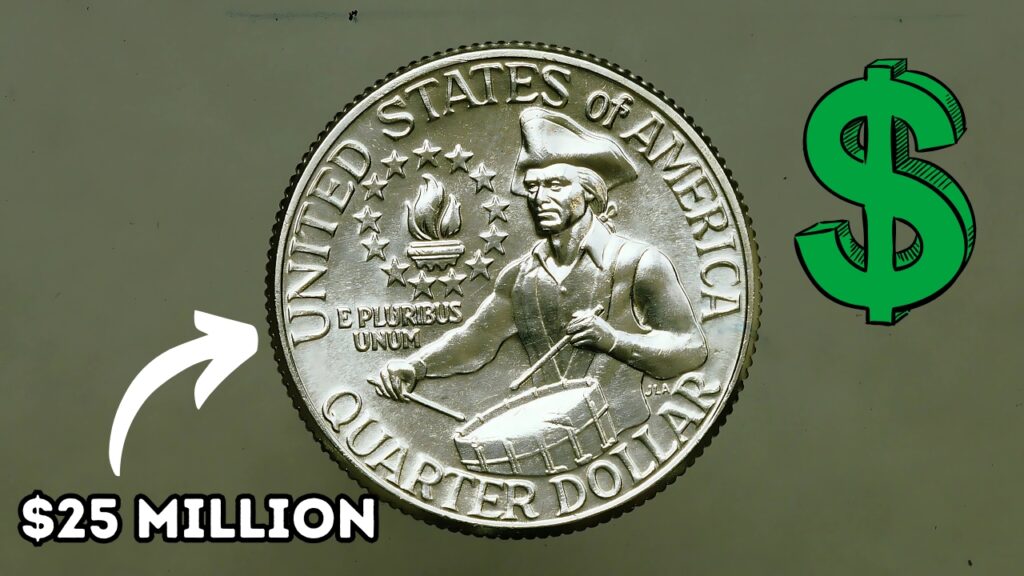Rare Bicentennial Quarter : Tucked away in the corners of cash registers, coin jars, or even your very own pockets, there could be one of the most exceptional treasures in the world of numismatics – a rare variety of the Bicentennial quarter that might be valued at an astonishing $25 million.
This isn’t just an exaggeration or an attention-grabbing headline; it’s a genuine appraisal for a uniquely rare minting mistake that seems to slip through the fingers of collectors while circulating in everyday transactions throughout the United States.
In the years 1975 and 1976, the United States Mint rolled out Bicentennial quarters as a way to honor America’s monumental 200th anniversary of independence.
These iconic quarters showcased a colonial drummer on one side and displayed dual dates, 1776-1976, on the other.
With over 1.7 billion commemorative quarters minted, these coins are relatively common and can still be found in circulation today.
Yet, hidden among these countless quarters lies an extraordinarily rare variant – believed to have only a handful of existing examples, with just one confirmed within the numismatic community.
The $25 Million Error: What Makes It Special
The astonishing coin stems from what experts refer to as a “double-die obverse” coupled with an overdate error specific to the Bicentennial release.
To put it simply, during the manufacturing process, the die used to strike the coin was mistakenly impressed twice at marginally different angles, producing a faint doubling effect that’s particularly visible on Washington’s profile, especially around the date and lettering.
This unique error coin holds more worth than other double-die quarters due to several distinct factors:
-
The error specifically occurred on the special Bicentennial design
-
The doubling is most notable on the dual dates (1776-1976)
-
The coin was struck on a copper-nickel planchet rather than silver
-
The error originated at the Philadelphia Mint (showing no mint mark)
“This is the ultimate culmination of error coin conditions,” states Lawrence Shepherd, a distinguished numismatic expert specializing in American currency.
“You have a historically significant commemorative design paired with a substantial minting mistake that, remarkably, managed to bypass quality control during a time of heightened public interest in coin collecting.”
Rare Bicentennial Quarter Verification Challenges and Authentication
The enormous value attached to this specific error coin brings with it a set of authentication challenges.
While several collectors have claimed to possess this rare quarter, most submissions for professional evaluation have turned out to be either altered coins or examples of machine doubling, which differs significantly from a true double-die error.
The Professional Coin Grading Service (PCGS) and the Numismatic Guaranty Corporation (NGC), leading authorities in coin authentication, have implemented stringent criteria for evaluating such examples.
Both agencies employ state-of-the-art microscopy and comparative analyses against known characteristics of the confirmed specimen.
“We inspect hundreds of Bicentennial quarters yearly from eager owners,” shares Maria Santiago, a senior authenticator at PCGS. “The genuine coin exhibits distinct doubling features that are impossible to replicate after it leaves the mint.
The doubling is particularly pronounced on the ‘776’ in the date and shows a consistent elevation across impacted elements.”
Rare Bicentennial Quarter Still in Circulation: The Ongoing Hunt
What makes this whole situation even more interesting is the possibility that more examples of this ultra-rare error could still be out there, quietly circulating in everyday commerce.
Unlike many valuable coins that were quickly removed from circulation due to their silver content or obvious visual cues, the Bicentennial quarter error looks similar to standard quarters at first glance.
Coin roll hunters, individuals passionate about searching through bank-wrapped coin rolls for valuable finds, have prioritized the Bicentennial quarter during their searches.
Online communities dedicated to this treasure hunt boast thousands of members who work together to examine millions of quarters each year.
“Most of the valuable coins from the 20th century were scooped up from circulation years ago,” mentions Robert Finkelstein, founder of the American Rare Coin Fellowship.
“This particular quarter represents possibly the last great hidden treasure that could be lurking right under our noses. Its value continues to rise due to its rarity and the increasing interest from collectors.”
Rare Bicentennial Quarter: What To Look For
For those everyday Americans dreaming of discovering numismatic gold, experts suggest checking any Bicentennial quarters for these specific features:
-
No mint mark (which indicates it was minted in Philadelphia)
-
Visible doubling on the date, especially notable on the “776” section
-
Doubling on “LIBERTY” and “IN GOD WE TRUST”
-
Standard copper-nickel color (not silver)
While the hunt is exciting, experts caution that authenticating these coins requires professional examination.
With such potential high values, the market has seen its share of altered coins and counterfeit replicas.
For the average coin enthusiast, this treasure hunt offers a thrilling chance to uncover life-changing value in pocket change – a modern-day adventure available to anyone willing to scrutinize their quarters closely.


